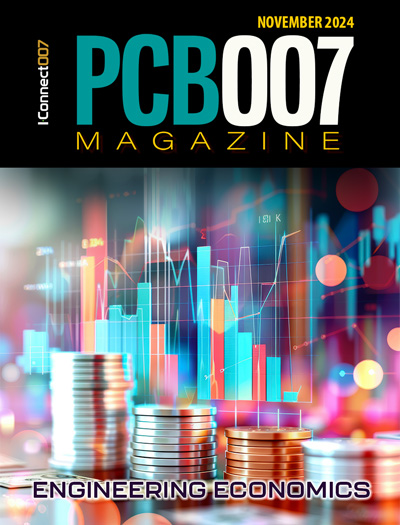-

- News
- Books
Featured Books
- pcb007 Magazine
Latest Issues
Current Issue
Fueling the Workforce Pipeline
We take a hard look at fueling the workforce pipeline, specifically at the early introduction of manufacturing concepts and business to young people in this issue of PCB007 Magazine.

Inner Layer Precision & Yields
In this issue, we examine the critical nature of building precisions into your inner layers and assessing their pass/fail status as early as possible. Whether it’s using automation to cut down on handling issues, identifying defects earlier, or replacing an old line...

Engineering Economics
The real cost to manufacture a PCB encompasses everything that goes into making the product: the materials and other value-added supplies, machine and personnel costs, and most importantly, your quality. A hard look at real costs seems wholly appropriate.
- Articles
- Columns
Search Console
- Links
- Media kit
||| MENU - pcb007 Magazine
Zuken Unveils CR-8000 2023 with Enhanced Design Efficiency, Analysis for High-Density, High-Speed PCB Designs
August 30, 2023 | ZukenEstimated reading time: 3 minutes
Zuken, a global leader in electronic design automation solutions, announces the availability of CR-8000 2023. The 2023 release is packed with new enhancements covering the entire design process and will empower users and enable them to tackle the challenges of high-density, high-speed PCB designs.
Notably, the CR-8000 2023 release places special emphasis on revitalizing and expanding the spectrum of signal integrity, power integrity, and electromagnetic compatibility (EMC) analysis tools. These advancements are seamlessly integrated into the CR-8000 Design Force Analysis Advance bundle, offering an unparalleled avenue for enhanced design insights.
"We are excited to unveil CR-8000 Release 2023, which empowers designers to address the ever-increasing demands of high-density, high-speed PCB designs," said Kazuhiro Kariya, Sr. Managing Executive Officer and CTO of Zuken Inc. "Through the strategic enhancements made to our flagship CR-8000 tool suite, we are providing our customers with a comprehensive solution that boosts design efficiency and supports accurate analysis, ultimately enabling them to stay ahead in today's competitive market."
Empowering Engineers with Advanced Design Creation
Streamlined Design Sheet Integration
With the CR-8000 2023 release, the process of generating new designs becomes a seamless journey. Users can effortlessly merge sheets from diverse designs, enabling the incorporation of various elements or the utilization of template designs as a solid foundation. This innovative feature fosters creativity and accelerates the design timeline.
Enhanced Information Security
Privacy takes center stage with the introduction of a resourceful feature that allows sensitive information exclusion before external sharing. Tailoring resource files to distinct collaboration needs fosters a secure and collaborative design environment.
Efficiency through Design Reuse
The 2023 release introduces a groundbreaking feature that streamlines documentation by enabling the copying, editing, and seamless integration of circuits and text elements. This innovation enhances efficiency by eliminating redundant tasks and allows engineers to focus on design evolution.
Expanded Design Efficiencies in Layout
Reuse Template Routing
Identical areas of components and routing that are common in multi-channel designs can now be placed and routed based on one instance. This function recognizes component and topology similarities and propagates the master instance to the subsequent channels.
Expanded Contour Routing
An interactive contour routing feature aligns seamlessly with existing patterns and board shapes, ensuring design harmony and consistency.
Analyze Track Configurations
Users can examine the routing of a trace path by visualizing a cross-sectional view that showcases the trajectory across various layers. This capability allows for comprehensive inspection and evaluation of track arrangements, aiding in identifying potential issues and optimizing the design.
Powerful Analysis Capabilities
Enhanced Bundle and Functionality
The CR-8000 2023 Release consolidates signal integrity, power integrity, and EMI analysis tools into new bundles, with enhanced user interaction, MultiCore CPU support, and compatibility with extensive datasets. AI/ML-assisted modeling and new Power Integrity checks elevate design and analysis prowess.
Comprehensive Signal Integrity Analysis
Dive into Signal Integrity with the Design Force SI Advance bundle, encompassing features from Characteristic Impedance to IBIS AMI SerDes channel analysis. Comprehensive system-level analysis is ensured through the inclusion of IBIS, SPICE, and S-Parameter models in both domains.
Full-spectrum PCB-level EMI and Power Analysis
The Design Force PI/EMI Advance bundle focuses on EMI and Power Supply System Analysis. Critical functions include rapid estimations, integrity features, and an array of analysis tools designed to optimize designs. Capabilities include IC power pin impedance computation, Decap location and parasitic values determination, DC analysis, incorporation of Lossy Transmission Line models considering copper surface roughness, and integration of IBIS, SPICE, and S-Parameter models. Time Domain Reflectometry (TDR) and Eye Pattern analysis enhance design evaluation. A comprehensive HSPICE export and capability to calculate and export S-Parameter Touchstone data add versatility to the toolset.
With the CR-8000 2023 release, users will be able to explore innovations that redefine design excellence. The release underscores Zuken’s commitment to empowering users with tools that simplify the challenges of intricate electronic design.
For more information about CR-8000 Release 2023 and other Zuken solutions, please visit the CR-8000 section on Zuken.com.
Suggested Items
DesignCon 2025, Day 2: It’s All About AI
01/30/2025 | Marcy LaRont, I-Connect007It’s hard to get away from the topic of artificial intelligence, but why would you? It’s everywhere and in everything, and my time attending presentations about AI at DesignCon 2025 was well worth it. The conference’s agenda featured engaging presentations and discussions focused on the technological advancements in AI, big data centers, and memory innovations, emphasizing the critical relationship between processors and circuit boards.
Beyond Design: Electro-optical Circuit Boards
01/22/2025 | Barry Olney -- Column: Beyond DesignPredicting the role of PCB designers in 10 years is a challenge. If only I had a crystal ball. However, we know that as technology progresses, the limitations of copper PCBs are increasingly apparent, particularly regarding speed, bandwidth, and signal integrity. Innovations such as optical interconnects and photonic integrated circuits are setting the stage for the next generation of PCBs, delivering higher performance and efficiency. The future of PCB design will probably incorporate these new technologies to address the challenges of traditional copper-based designs.
Designers Notebook: Impact of Advanced Semiconductor Packaging on PCB Stackup
01/07/2025 | Vern Solberg -- Column: Designer's NotebookTo accommodate new generations of high I/O semiconductor packaging, printed circuit board fabrication technology has had to undergo significant changes in both the process methods and the criteria for base material selection and construction sequence (stackup). Many of the new high-function multi-core semiconductor package families require more terminals than their predecessors, requiring a significantly narrower terminal pitch. Interconnecting these very fine-pitch, high I/O semiconductors to the PCB is made possible by an intermediate element referred to as an interposer.
BOOK EXCERPT: The Printed Circuit Designer’s Guide to... High Performance Materials, Chapter 4
01/02/2025 | I-Connect007In Chapter 4, Michael Gay discusses the two main types of copper foil used for PCB boards today: electrodeposited (ED) foil and rolled annealed (RA) foil. He also explains the pros and cons of each, and provides an update of the latest innovations in copper foil technology.
Connect the Dots: Designing for Reality—Solder Mask and Legend
01/02/2025 | Matt Stevenson -- Column: Connect the DotsIn the previous episode of I-Connect007’s On the Line with… podcast, we discussed the strip, etch, and strip process. At this point, we have a functioning board, but we still need to protect the PCB from environmental effects and document the circuit components. This brings us to the solder mask and legend phase of production.


